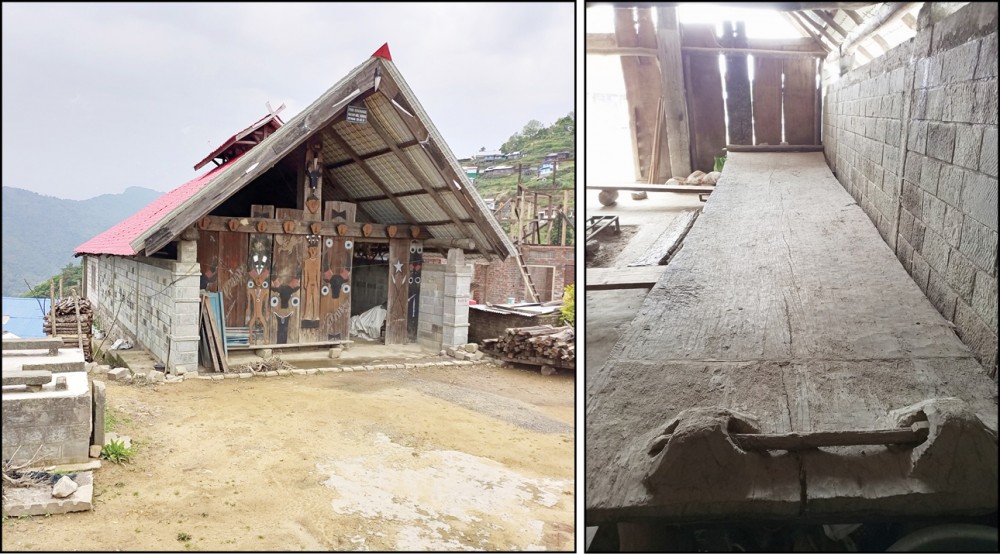‘Pwading Zoi’, the giant log bed carved from a single tree adorns the Hausemkhel Morung in Poilwa village.

Ashikho Pfuzhe
Poilwa | June 5
Pwading, a chieftain of ‘Bukpoilwame’ village (present Poilwa), scouted the entire Mt Langdilwa range (Mount Pauna), the highest mountain peak in Peren district, in search of the biggest tree.
The chieftain spotted one on the lower reaches of the majestic peak; a giant ‘Ngga’ (bonsum) tree.
And for the next 5-6 months from morning till dusk, Pwading chipped away the trunk of the giant tree to accomplish a mission - to carve a large bed from the tree to accommodate the growing number of youths in his ‘Morung.’
Every morning, he filled his wine gourd, packed his lunch and cutting tools and trudged to his cutting spot, about 4kms away from his village.
Like an animated woodpecker, he chipped and hewed away the tree trunk with his axe and ‘dao’ (machete) the whole day and returned to his village only after sunset.
One evening as he was returning from his day’s work of cutting the tree, he heard a loud whirring sound carried by the wind.
Immediately he turned his head in the direction of the sound and saw his tree crashing down to the ground with a thunderous boom, the impact of the crash reverberating on the ground where he stood.
Seeing that the giant tree had at last bowed down to his persistent blows, the village chieftain gave a triumphant yell, sipped the remaining wine from his gourd jar and fell to the ground to take a long nap.
Pwading’s tryst with the giant tree has now merged into folklore as it took place many generations ago and the chieftain is long gone. But his log bed still stands: a testimony to man’s capacity for endurance and hard labour.
The giant log bed called ‘Pwading Zoi’ (Zoi meaning bed in Zeme dialect) adorns the Hausemkhel Morung (Diswang Cha Me Ki), one of the biggest and oldest among the 20 morungs in Poilwa village.
Measuring around 35 feet (length) and 8.7 feet (breadth), Pwading Zoi might as well be the biggest log bed in the world hewn from a single tree.
According to Zeme forefathers, it was believed that beds made of ‘Ngga’ enhance longevity of those who slept on them.
As per village elders, the original size of the bed was bigger than the present size.
Retelling accounts passed down from generations, an elder of Poilwa said that at the height of the Zeliangrong Movement against the British Rule, Rani Gaidinliu had come to Poilwa village in the later part of August 1932 to recruit volunteers in the movement started by her father HaipouJadonang.
Rani had stayed in Hausemkhel Morung for two months before the British soldiers led by one Captain Macdonald of the 29th Assam Rifles came and arrested her on 17th October, 1932.
It was reported that the British soldiers vented their ire against Rani’s stay in the Morung by cutting and hacking Pwading’s Zoi with their swords and blades.
“After repairing and smoothing out the damage done by the British soldiers, the size of the bed narrowed down”, he added.
Poilwa village elders estimated the log bed to be some 500 years old as Pwading is believed to have lived some 17-18 generations ago.
The spot where Pwading rested and drank his wine as he heard the giant tree fall is still called ‘Pwading Zau Toi Kie’ (Zau-rice beer, Toi- to drink and Kie-valley).
According to village lore, Pwading used cotton yarn mats to cushion his knees as he had to cut the tree at the base. In the course of six months, seven mats were reduced to rags with holes in spots where the chieftain rested his knees.
As per the lore retold, Pwading slaughtered pigs, mithuns, chickens and brewed huge quantity of rice beer while engaging the villagers to pull the giant log with vine ropes to the village.
When the log reached the spot where he rested (Pwading Zau Toi Kie), he threw a feast for all villagers taking part in the log pulling ceremony.
Poilwa, an ancestral Zeme village perched on a hill top is surrounded by mountain ranges with lush evergreen forests, meandering rivers and valleys.
The village lies on the Barail ranges bordering Senapati district of Manipur in the North-East and Western Angami areas in the South-West.
The village is about 50km from the state capital Kohima, 130 kms from Dimapur and 70km from Peren district headquarters.






